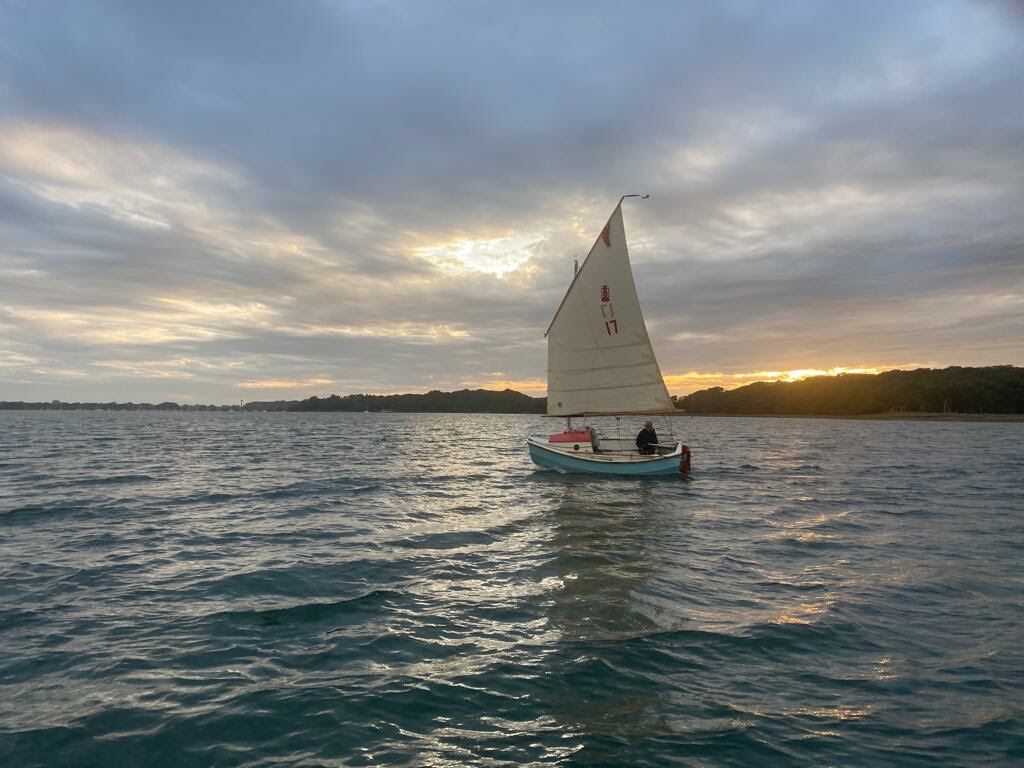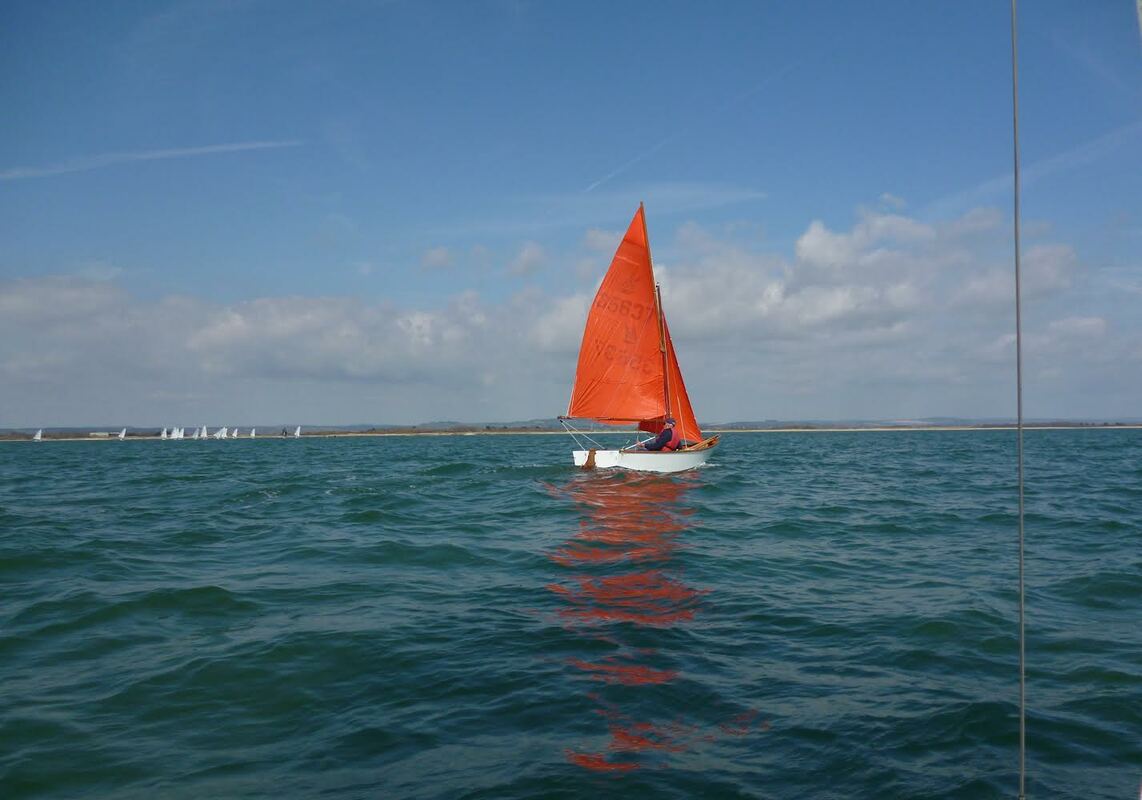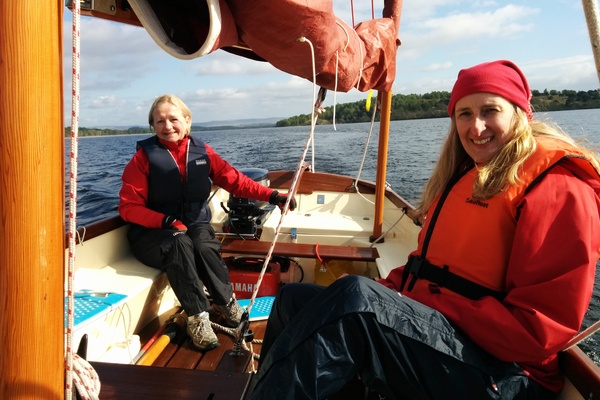The Dinghy Cruising Association stand at this year's RYA Dinghy & Watersports Show is devoted to the theme of women sailors. Visitors will also learn how to get started in dinghy cruising and why it is the greenest and most cost-effective form of sailing.
On display will be three very different boats sailed by women DCA members who are keen dinghy cruisers. The trio of skippers - Mary Dooley, Carmel Royston and Pat Ditton - will be among DCA members at the stand, happy to explain what dinghy cruising can offer to independent-minded men and women.
Of course, their eye-catching boats are expected to attract plenty of attention in their own right. Mary sails a colourful SCAMP, Rhubarbie, a design that is still rare in the UK but gaining popularity worldwide. Carmel sails a classic Tideway 12, Baggywrinkle, on the Welsh coast with Charles Felgate. Pat refurbished her 1965 Mirror, Heron, after it had been garage stored for 50 years in the original family’s ownership.

Mary's Story
In my 40s I decided to do the RYA level 1 and 2 courses at a sailing centre in Falmouth. and then occasionally sailed in club dinghies on summer beach holidays. On a walking holiday I got chatting to a DCA member who told me about dinghy cruising, and the idea of camping in a boat on remote inland waters was a complete light bulb moment for me. I joined the DCA, crewed with other members for a year and then bought myself a Mirror dinghy which I took to the DCA Cobnor summer camp with no knowledge of how to sail or rig it. All the DCA members helped and supported me to get started, and I never looked back.
Check YouTube for a video in which Mary explains how to use a pop-up tent to camp on board a Mirror dinghy.

Mary now sails a SCAMP. Rhubarbie was built around 2013 by DCA member David Spensley in Hartlepool and bought by Mary in 2022. Since then she has been equipped with boards and a popup tent, an electric outboard and a battery which lives under the cuddy. Her designer is John Welsford who was guest speaker at the DCA AGM in 2021. The class name SCAMP is an acronym of Small Craft Advisor Magazine Project because it was designed with two magazine editors who listed the best features of 70 boats they had tested, including: an offset centreboard that leaves the cockpit clear, a stowage cabin/cuddy, two skegs for beaching, five watertight buoyancy areas, and 77 kg of water ballast under the cockpit sole.

Pat's Story
In Autumn 2021, I spotted 3 traditional looking dinghies coming ashore on East Head, Chichester. That’s how I met with the DCA and its brilliant ethos. A few months later, I bought this Mirror dinghy. I wanted a larger dinghy but had to balance that with being independent in launching and recovery in my dotage.
My first sailing dinghy was in 1959. I have had a range of them over the years, many sailed single handed. 20 years ago I transitioned into crewing on cruising keelboats. And now … setting up a small dinghy for overnight cruising is certainly a very different challenge. The generosity of DCA members sharing their knowledge and skills has been very much appreciated. Having made up sleeping boards and boom tarp tent, my first overnight rally was at Poole.

Pat's dinghy Heron was built around 1965 and is a great example of one of the most popular dinghies ever designed. It spent 50 years in a garage before Pat bought it! As well as the camping modifications, Pat has fitted a tiller impeder, deep reefing and lazy jacks/boom raiser. Over this winter Heron was fully re-varnished inside (the first for 50+ years) and treated to various new fixings for easier handling - all ready for the Dinghy Show and another year of sailing. Next on Pat’s list are setting up capsize lines and installing a compass.
The Mirror was designed by prolific dinghy creator Jack Holt in 1962 and was promoted with the Daily Mirror newspaper. It’s red sails reflect the the red-top tabloid’s masthead.

Carmel's Story
Baggywrinkle was purchased as a joint venture by her current owners, Carmel and Charlie, who discovered a mutual desire to go dinghy cruising post-lock down, thanks to Roger Barnes' talk at the online RYA Dinghy Show during Covid and his YouTube videos.
"After much research, we had settled on the Tideway Dinghy as the boat we wanted. Being 12ft in length, a Tideway will fit in a garage easily but is also big enough for two. It was important for us to choose a boat we felt either of us could manage single-handed if needed. Originally, we started our hunt for a GRP version, but after not much luck, we were contacted by the then owners of Baggywrinkle, and having discovered she is the boat we'd seen in Roger Barnes' videos and on the back cover of the first edition of "The Dinghy Cruising Companion" which made us fall in love with dinghy cruising, we decided we just had to go and take a look at her!"

"Baggywrinkle had already had some adaptations made to her for dinghy cruising, including her tabernacle mast (which makes raising and lowering the mast and sails quick and easy), wooden galley boxes and a fitted canvas boom tent, so although we were apprehensive about owning a wooden boat at first, the fact she came sail-and-camp-ready sold her to us."
Baggywrinkle was built in the 1960s out of mahogany on oak wood. Originally owned by Roger Barnes, (when she had wooden varnished top sides and white waterline) she made many voyages of discovery in the Bristol Channel. Now usually helmed by Carmel, she hails from the Welsh Coast and is sailed almost exclusively on the sea. Charlie crews as he already has a 2000 which he helms and races competitively, and after some trial and error, this was the best way to prevent arguments aboard!
Note:
"Baggywrinkle" is a nautical term for a soft covering made for cables (or any other obstructions) to reduce sail chafe.




2 comments
You must be logged in as a member to add comments.
Become a member
Already a member? Log in or create an account.